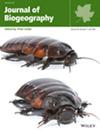Host-Cleptoparasite Biogeographical Congruence Through Time: The Case of Cuckoo Oil Bees
Abstract
Aim
Insect brood parasites (i.e., cleptoparasites), like cuckoo bees, typically attack hosts within specific lineages, but seem to be less constrained by the biogeographical movements of their hosts compared to obligate parasites. Cuckoo bees depend on stable host populations, being particularly sensitive to environmental changes and thus valuable bioindicators of the bee community health. We here test the congruence between the biogeographical history of cuckoo oil bees and their oil bee hosts.
Location
The Americas.
Taxon
Bees (Hymenoptera, Apidae).
Methods
Using phylogenomic and Sanger sequence data, we present new time-calibrated phylogenies for cuckoo oil bees in the ericrocidine line and their oil bee hosts, Centris and Epicharis. We estimate their ancestral ranges using six historical biogeographical models on a set of 100 trees, randomly sampled from the posterior distribution of phylogenies in each group, thus accounting for uncertainties in divergence time estimates and model selection.
Results
The origin of the hosts stem in the Cretaceous precedes the origin of their cleptoparasite's stem in the Palaeocene. Cleptoparasite and host crown origins were synchronous in the Eocene, and both took place in tropical South America. While the pair Rhathymini-Epicharis remained mostly associated within this region, Centris and their cleptoparasites expanded their distribution to other parts of Neotropical and Nearctic regions in independent range expansions events. In all cases, host range shifts preceded the cleptoparasite shifts.
Main Conclusion
The biogeographical history of cleptoparasitic oil bees and oil-collecting hosts is generally congruent in time and space. Events of range expansion mainly occurred in the more species-rich lineages of cleptoparasites. Range shifts in cleptoparasites followed the distribution of their hosts and coincided with the distribution of oil-producing plants visited by the host bees. Our results broaden our understanding of the complex biogeography of interacting partners and on how changes in host distributions may impact cleptoparasitic bees.


 求助内容:
求助内容: 应助结果提醒方式:
应助结果提醒方式:


